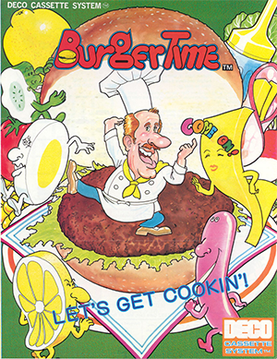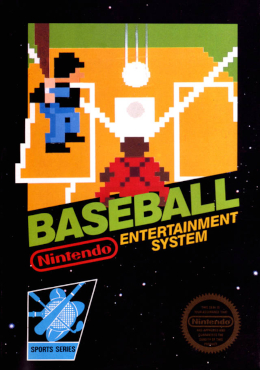
The Neo Geo, stylized as NEO•GEO and also written as NEOGEO, is a ROM cartridge-based arcade system board and fourth generation home video game console released on April 26, 1990, by Japanese game company SNK Corporation. It was the first system in SNK's Neo Geo family.

Data East Corporation, also abbreviated as DECO, was a Japanese video game, pinball and electronic engineering company. The company was in operation from 1976 to 2003, and released 150 video game titles. At one time, the company had annual sales of 20 billion yen in the United States alone but eventually went bankrupt. The American subsidiary, Data East USA, was headquartered in San Jose, California. Its main headquarters were located in Suginami, Tokyo.

BurgerTime, originally released as Hamburger in Japan, is a 1982 arcade video game from Data East released initially for its DECO Cassette System. The player is chef Peter Pepper, who must walk over hamburger ingredients in a maze of platforms and ladders while avoiding anthropomorphic hot dogs, fried eggs, and pickles which are in pursuit.
1983 has seen many sequels and prequels in video games, such as Mario Bros. and Pole Position II, along with new titles such as Astron Belt, Champion Baseball, Dragon's Lair, Elevator Action, Spy Hunter and Track & Field. Major events include the video game crash of 1983 in North America, and the third generation of video game consoles beginning with the launch of Nintendo's Family Computer (Famicom) and Sega's SG-1000 in Japan. The year's highest-grossing video game was Namco's arcade game Pole Position, while the year's best-selling home system was Nintendo's Game & Watch for the third time since 1980.

Excitebike is a motocross racing video game developed and published by Nintendo. In Japan, it was released for the Famicom in 1984 and then ported to arcades as Vs. Excitebike for the Nintendo Vs. System later that year. In North America, it was initially released for arcades in 1985 and then as a launch game for the Nintendo Entertainment System later that year, becoming one of the best-selling games on the console. It is the first game in the Excite series.

Track & Field, also known as Hyper Olympic in Japan and Europe, is a 1983 Olympic-themed sports video game developed by Konami for arcades. The Japanese release sported an official license for the 1984 Summer Olympics. In Europe, the game was initially released under the Japanese title Hyper Olympic in 1983, before re-releasing under the US title Track & Field in early 1984.

The Nintendo VS. System is an arcade system developed and produced by Nintendo from 1984 to 1990. It is based on most of the same hardware as the Family Computer (Famicom), later released as the Nintendo Entertainment System (NES). Most of its games are conversions from the Famicom and NES, some heavily altered for the arcade format, and some debuted on the VS. System before being released on the Famicom or NES. The system focuses on two-player cooperative play. It was released in three different configurations: upright VS. UniSystem cabinets, upright VS. DualSystem cabinets, and sit-down VS. DualSystem cabinets. Games are on pluggable circuit boards, allowing for each side to have a different game.

Kung-Fu Master, known as Spartan X in Japan, is a side-scrolling beat 'em up game developed by Irem as an arcade game in 1984, and distributed by Data East in North America. Designed by Takashi Nishiyama, the game was based on Hong Kong martial arts films. It is a loose adaptation of the Jackie Chan, Sammo Hung, and Yuen Biao film Wheels on Meals (1984), called Spartan X in Japan, with the protagonist Thomas named after Jackie Chan's character in the film. The game is also heavily inspired by the Bruce Lee film Game of Death (1972), which was the basis for the game's concept. Nishiyama, who had previously designed the side-scrolling shooter Moon Patrol (1982), combined fighting elements with a shoot 'em up gameplay rhythm. Irem and Data East exported the game to the West without the Spartan X license.

Operation Thunderbolt is a light gun shooter video game developed by Taito and released for arcades in 1988. As the sequel to Operation Wolf, changes include two-player gameplay with two positional gun controllers mounted on the arcade cabinet, and a new forward-scrolling pseudo-3D perspective combined with side-scrolling sections.
1985 saw many sequels and prequels in video games, such as Super Mario Bros. and Kung Fu, along with new titles such as Commando, Duck Hunt, Gauntlet, Ghosts 'n Goblins, Gradius, Hang-On, Space Harrier, Tetris and The Way of the Exploding Fist. The year's highest-grossing arcade video games were Hang-On and Karate Champ in the United States, and Commando in the United Kingdom. The year's best‑selling home system was the Nintendo Entertainment System (Famicom) for the second year in a row, while the year's best‑selling home video game was Super Mario Bros and duck hunt.
1980 saw the release of a number of games with influential concepts, including Pac-Man, Battlezone, Crazy Climber, Mystery House, Missile Command, Phoenix, Rally-X, Space Panic, Stratovox, Zork, Adventure, and Olympic Decathlon. The year's highest-grossing video game was Namco's arcade game Pac-Man, while the best-selling home system was Nintendo's Game & Watch. The Atari VCS also grew in popularity with a port of Space Invaders and support from new third-party developer Activision.
In video games, a combo is a set of actions performed in sequence, usually with strict timing limitations, that yield a significant benefit or advantage. The term originates from fighting games where it is based upon the concept of a striking combination. It has been since applied more generally to a wide variety of genres, such as puzzle games, shoot 'em ups, and sports games. Combos are commonly used as an essential gameplay element, but can also serve as a high score or attack power modifier, or simply as a way to exhibit a flamboyant playing style.

Baseball is a video game from Nintendo. It was released December 7, 1983, after the July 15 launch of the Famicom in Japan. In 1984, it was ported to the VS. System arcade as VS. Baseball with additional graphics and speech, becoming a number one hit in Japan and North America that year. It was localized as a Nintendo Entertainment System launch game in North America in 1985, and in Europe in 1986. IGN said the universal appeal of the American sport made Baseball a key to the NES's successful test market introduction, and an important piece of Nintendo history. The game was also competing with Sega's arcade hit Champion Baseball, released earlier in 1983.

Captain America and the Avengers is a beat 'em up arcade game developed and released by Data East in 1991. It features the Avengers team of Marvel Comics characters in a side-scrolling brawling and shooting adventure to defeat the evil Red Skull. The game received ports for the Sega Genesis/Mega Drive, Super Nintendo Entertainment System, Game Boy and Game Gear. A different Data East game was released for the Nintendo Entertainment System.

Alpha Mission, known as ASO: Armored Scrum Object in Japan, is a vertically scrolling shooter developed by SNK and released as an arcade video game in 1985 by Namco in Japan and Tradewest in North America. It was later ported to the Famicom in 1986 and released for the Nintendo Entertainment System in 1987.

Gun.Smoke is vertically scrolling run and gun video game and designed by Yoshiki Okamoto and released in arcades in 1985. Gun.Smoke centers on a character named Billie Bob, a bounty hunter going after the criminals of the Wild West.

Champion Baseball is an arcade baseball video game developed by Alpha Denshi and published by Sega in March 1983. It was a sophisticated sports video game for its time, displaying a split-screen format, with the playfield viewed from two camera angles, one from the outfield and another close-up shot of the batter and pitcher, while giving players the option of selecting relief pitchers or pinch hitters and with an umpire looking on attentively to make the game calls. The game also had digitized voices for the umpire, and individual player statistics. A person could play for hours with one token providing they tied scores at the 9th and further innings.
In video gaming parlance, a conversion is the production of a game on one computer or console that was originally written for another system. Over the years, video game conversion has taken form in a number of different ways, both in their style and the method in which they were converted.

Monaco GP is an arcade racing game released by Sega in November 1979 in Japan, and January 1980 worldwide. An upgraded version, Pro Monaco GP, was released later in 1980. One of the last Sega games to use TTL chips instead of a microprocessor CPU, the game has players race against a clock and pass rival racers while attempting to earn points driving through five areas.














